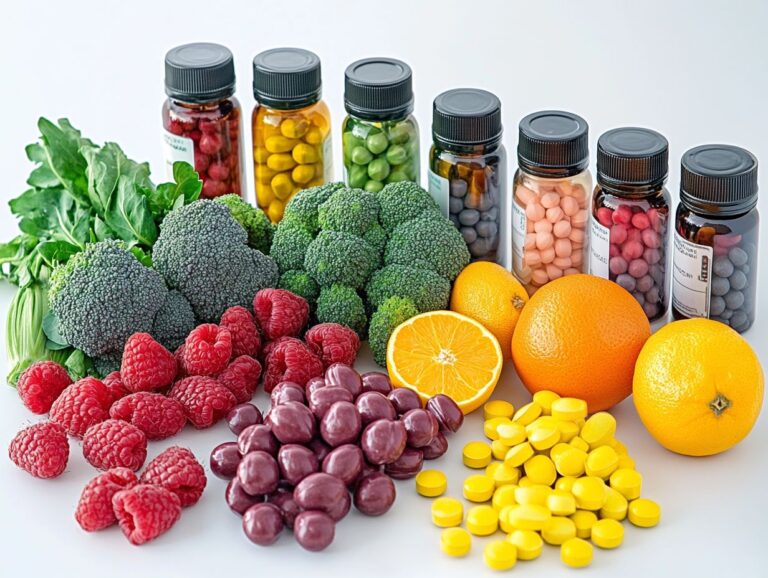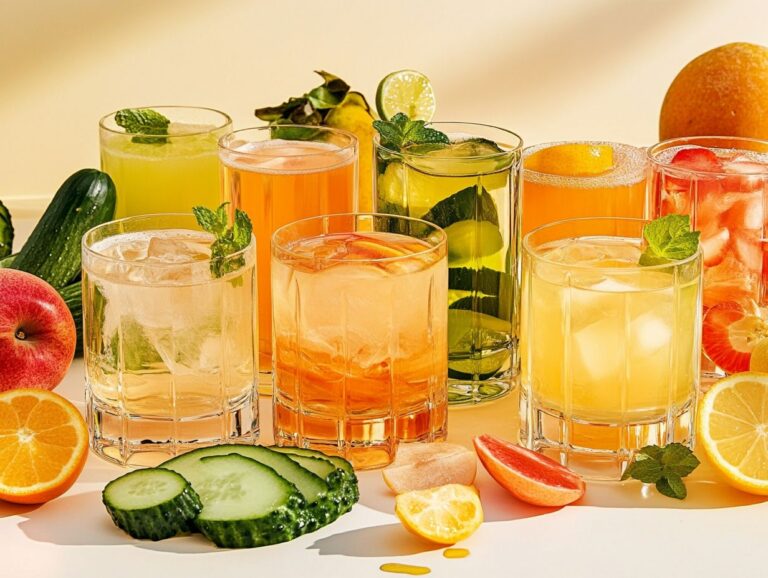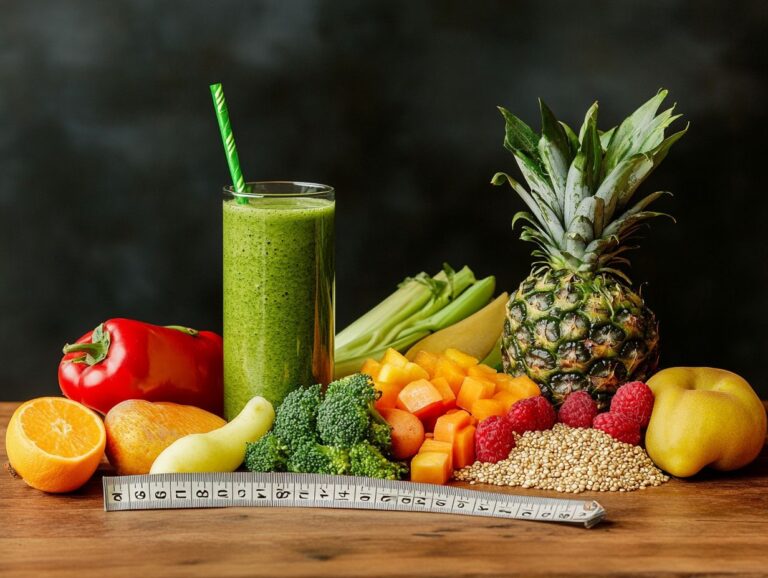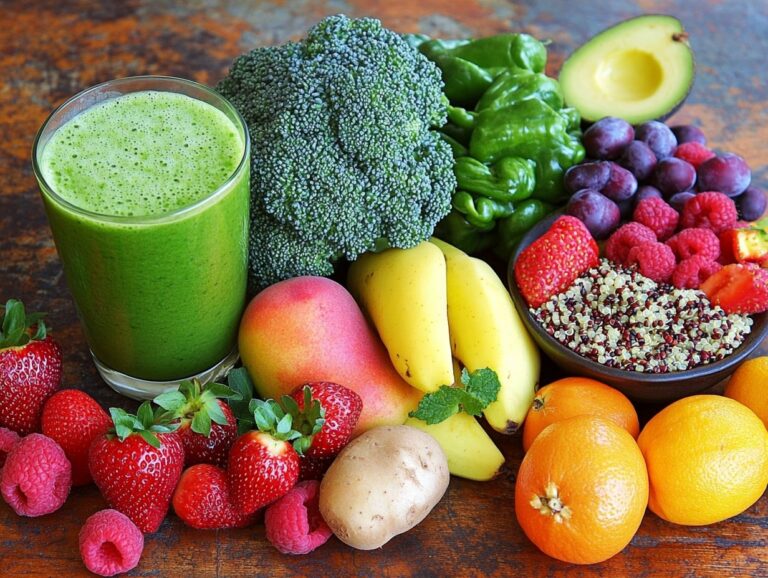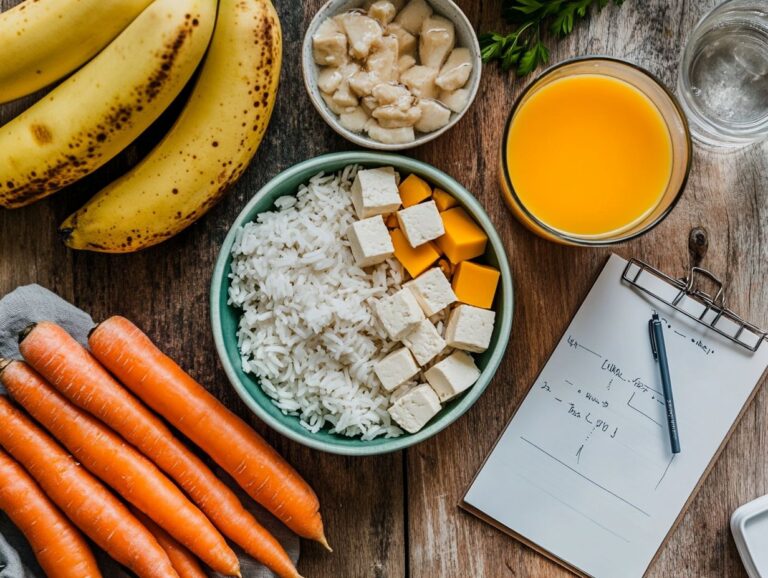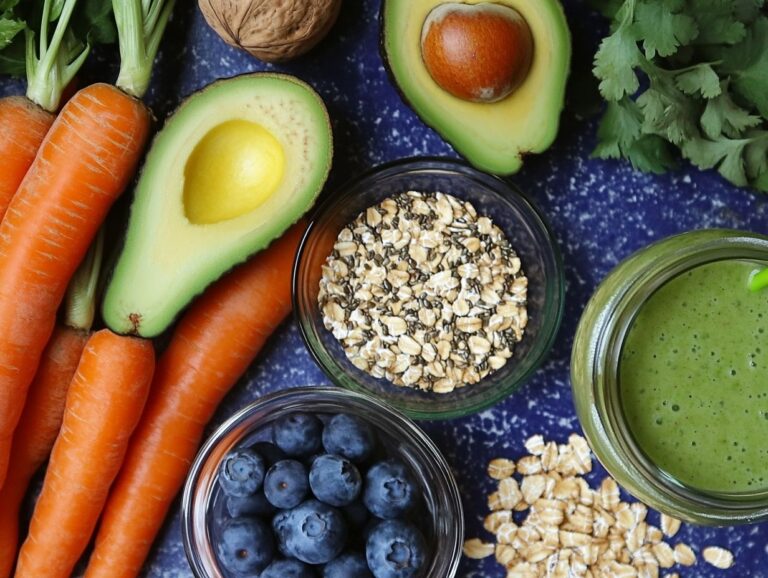Iron is an essential nutrient, particularly for individuals following a plant-based diet. Although many people associate red meat with being the primary source of iron, there are numerous delicious and nutritious plant-based alternatives that can help maintain healthy iron levels. This article explores the top sources of iron, including legumes, leafy greens, whole grains, nuts, and dried fruits. Additionally, it offers tips on maximizing iron absorption, along with mouthwatering vegan recipes to help you incorporate these foods into your meals. Discover how simple it can be to nourish your body with iron-rich plant foods!
Key Takeaways:
- Legumes, leafy greens, whole grains, nuts and seeds, dried fruits, and dark chocolate are among the top plant-based sources of iron for a vegan diet.
- To maximize iron absorption, pair iron-rich foods with vitamin C, avoid consuming iron inhibitors, and cook foods in cast iron cookware.
- Some delicious vegan recipes that are rich in iron include lentil and vegetable soup, spinach and chickpea curry, quinoa and black bean salad, tofu and broccoli stir-fry, and oatmeal with almond butter and berries.
What are the Top Plant-Based Sources of Iron?
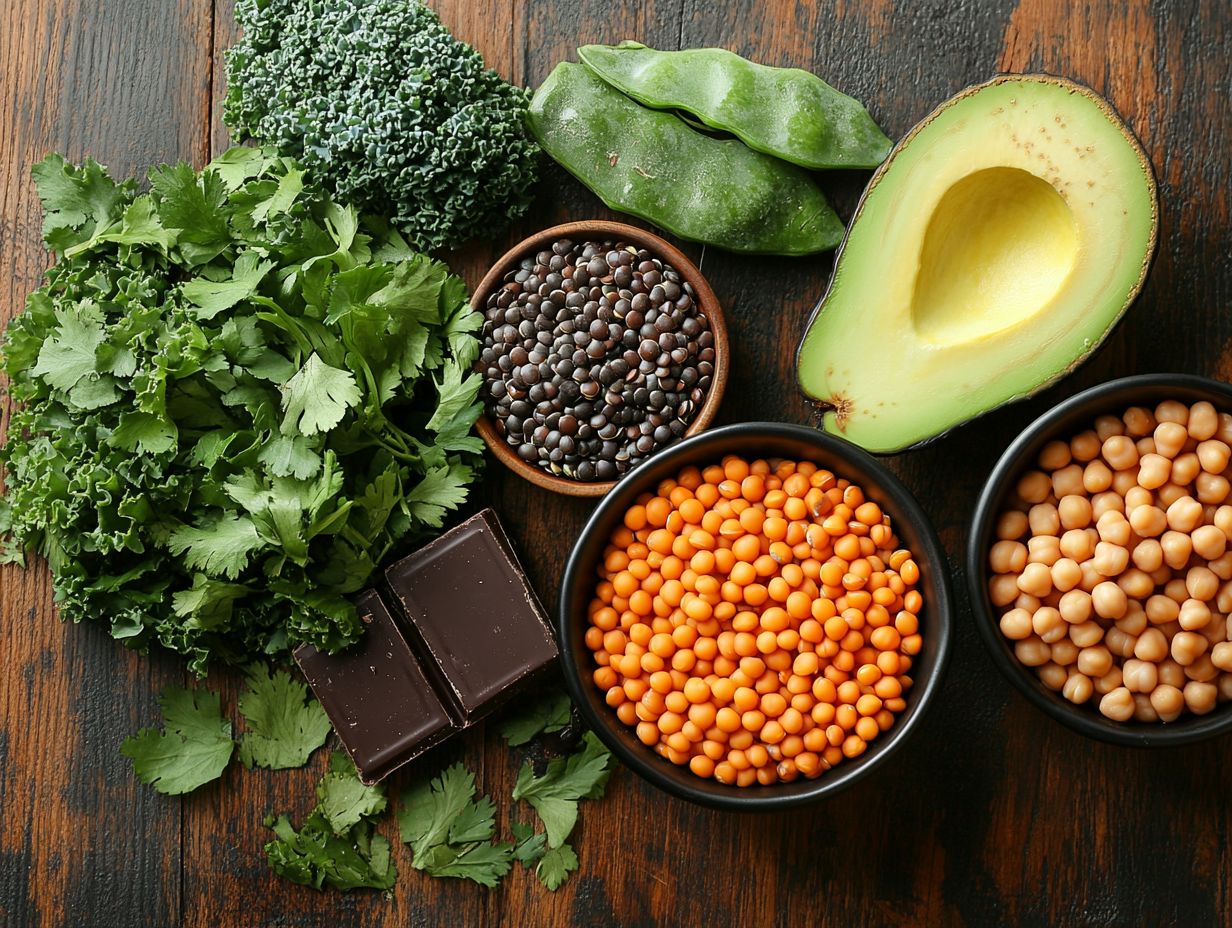 Iron is an essential mineral crucial for optimal health, particularly for individuals following a vegan diet, as they do not obtain heme iron from animal products. Non-heme iron from dietary sources is vital for maintaining hemoglobin levels and preventing anemia. Consequently, those adhering to a plant-based diet must consume dietary sources rich in non-heme iron to maintain hemoglobin levels and prevent anemia. Non-heme iron is found in non-animal products, including plant-based foods and fortified cereals. However, the body absorbs non-heme iron less efficiently than heme iron, and absorption can be inhibited by certain food components such as phytates, tannins, and calcium, as well as by various medical conditions. Therefore, individuals consuming a non-heme iron diet should be mindful of the factors affecting its absorption efficiency, including the presence of phytates and the consumption of vitamin C-rich foods. The following sections will discuss various iron-rich foods that can help meet the dietary needs of those on a plant-based diet.
Iron is an essential mineral crucial for optimal health, particularly for individuals following a vegan diet, as they do not obtain heme iron from animal products. Non-heme iron from dietary sources is vital for maintaining hemoglobin levels and preventing anemia. Consequently, those adhering to a plant-based diet must consume dietary sources rich in non-heme iron to maintain hemoglobin levels and prevent anemia. Non-heme iron is found in non-animal products, including plant-based foods and fortified cereals. However, the body absorbs non-heme iron less efficiently than heme iron, and absorption can be inhibited by certain food components such as phytates, tannins, and calcium, as well as by various medical conditions. Therefore, individuals consuming a non-heme iron diet should be mindful of the factors affecting its absorption efficiency, including the presence of phytates and the consumption of vitamin C-rich foods. The following sections will discuss various iron-rich foods that can help meet the dietary needs of those on a plant-based diet.
1. Legumes
Legumes, such as beans, lentils, and chickpeas, are among the best sources of iron. They provide a wide array of essential nutrients, including fiber, protein, and calcium, which are crucial for a balanced vegan diet. These iron-rich foods not only help increase iron levels but may also play a significant role in preventing anemia. Black beans are a high-iron option that can be added to salads or used in soups. Lentils can be served as a side dish or incorporated into soups and stews, making them a great grain-free alternative that is rich in iron. Chickpeas can be added to salads, transformed into hummus, or roasted for a crunchy snack. Incorporating these legumes into daily recipes can enhance iron levels while also adding flavor.
2. Leafy Greens
Leafy greens, particularly spinach, are excellent sources of iron and also provide essential minerals and vitamins, such as vitamin C, which can enhance iron absorption. Other leafy varieties, including kale, collard greens, and Swiss chard, are also rich in iron and offer various health benefits, such as supporting immune function and reducing the risk of heart disease and certain cancers. For instance, kale is high in calcium, which is vital for bone formation, while Swiss chard is a significant source of potassium, important for heart function. The iron content in these green vegetables can be further improved by cooking them lightly; methods like steaming or saut ing can reduce oxalates that inhibit iron absorption. Additionally, consuming these vegetables alongside foods rich in vitamin C, such as bell peppers or citrus fruits, can significantly boost iron absorption.
3. Whole Grains
Whole grains, such as quinoa and oatmeal, are excellent sources of iron, fiber, and other essential nutrients in a vegan diet. Incorporating a variety of whole grains like farro, brown rice, and barley into meals can enhance overall well-being and boost energy levels. These grains are rich in vital nutrients, including B vitamins and antioxidants, which play important roles in the body s metabolic processes. Quinoa, a complex carbohydrate, contains all nine essential amino acids, while oats have been shown to help regulate cholesterol levels. Delicious options for integrating these nutrient-dense ingredients into your daily meals include:
- Grain bowls with roasted vegetables and legumes
- Adding whole grain pasta to salads
Not only do these additions improve taste and texture, but they also increase the iron content of your meals.
4. Nuts and Seeds
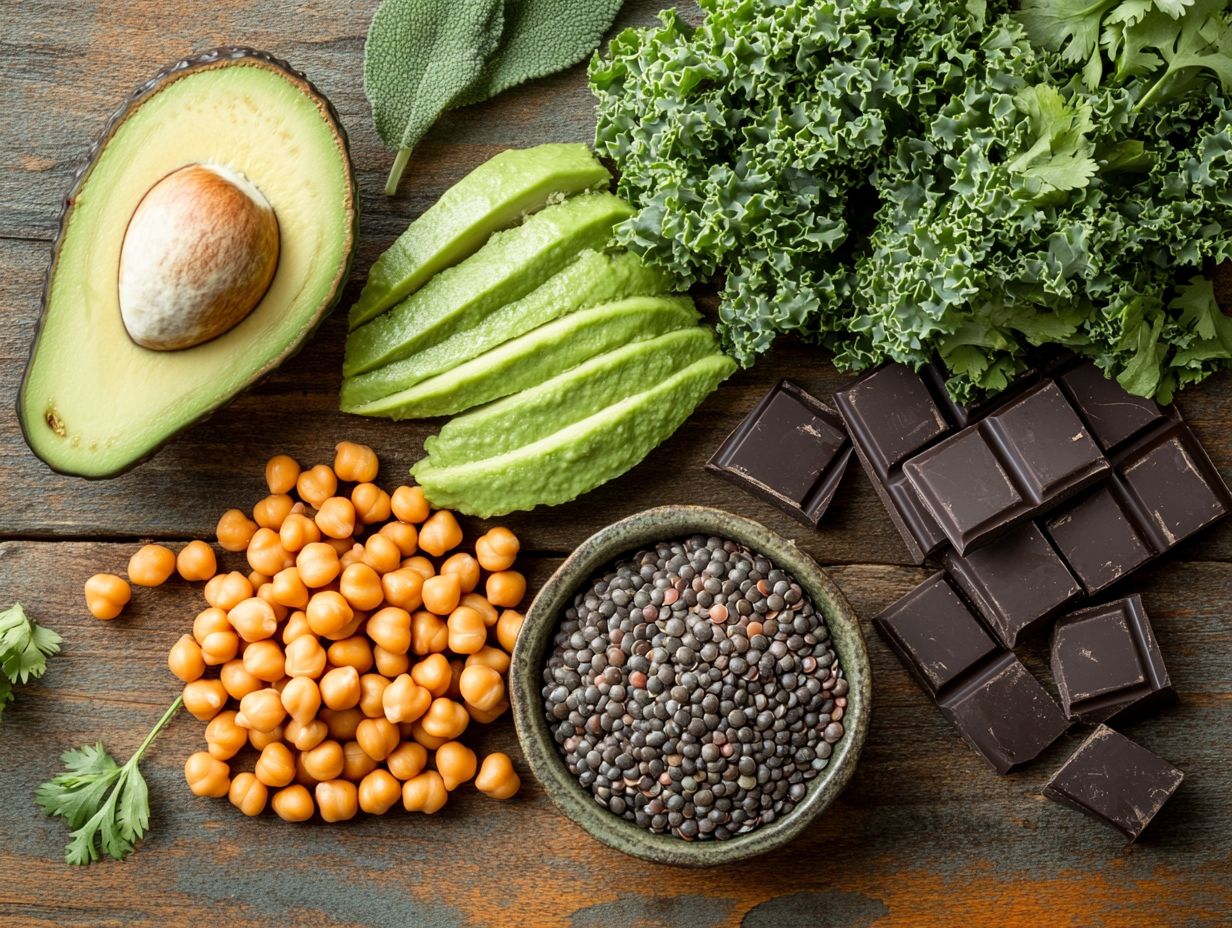 Nuts and seeds, such as pumpkin seeds, almonds, and chia seeds, are rich in iron as well as healthy fats and essential nutrients that contribute to overall good health. Incorporating these nutrient-dense foods into a vegan diet can enhance a person’s iron intake, which is vital for providing energy and supporting metabolic processes. The high iron content of pumpkin seeds makes them easy to include in various meals; they can be sprinkled on salads, blended into smoothies, or enjoyed as a snack. Similarly, almonds are also high in iron and can be consumed as a snack, added to salads, or used as a topping for oatmeal. Cashews are another nut that provides a significant amount of iron, while chia seeds and hemp seeds are examples of iron-rich seeds. These foods can be easily integrated into the diet in various ways, improving both iron intake and overall nutrition.
Nuts and seeds, such as pumpkin seeds, almonds, and chia seeds, are rich in iron as well as healthy fats and essential nutrients that contribute to overall good health. Incorporating these nutrient-dense foods into a vegan diet can enhance a person’s iron intake, which is vital for providing energy and supporting metabolic processes. The high iron content of pumpkin seeds makes them easy to include in various meals; they can be sprinkled on salads, blended into smoothies, or enjoyed as a snack. Similarly, almonds are also high in iron and can be consumed as a snack, added to salads, or used as a topping for oatmeal. Cashews are another nut that provides a significant amount of iron, while chia seeds and hemp seeds are examples of iron-rich seeds. These foods can be easily integrated into the diet in various ways, improving both iron intake and overall nutrition.
5. Dried Fruits
Dried fruits, especially apricots and raisins, make for convenient snacks that are rich in iron and other beneficial nutrients like potassium and vitamin C, which enhance iron absorption. Eating these iron-rich dried fruits daily can be both enjoyable and healthy. Apricots not only provide a good source of iron but also contain vitamins A and C, which contribute to overall well-being. Raisins are a versatile snack; they can be eaten on their own, sprinkled on morning cereals, added to salads, or used as a natural sweetener in baked goods. Regular consumption of dried fruits like apricots and raisins can help improve iron levels, reducing the risk of deficiency, particularly for individuals following plant-based diets or those with higher iron needs. They can be enjoyed in the morning by adding a handful to cereal or as a healthy afternoon snack.
How to Maximize Iron Absorption from Plant-Based Sources?
Vegans and individuals with iron deficiency must maximize iron absorption from plant sources, as non-heme iron found in plant foods is less efficiently absorbed than heme iron from animal products. To optimize absorption, it is beneficial to pair iron-rich foods with vitamin C and to avoid consuming inhibitors of iron absorption, such as calcium and phytates, during meals.
1. Pair Iron-Rich Foods with Vitamin C
Pairing iron-rich foods with vitamin C can significantly improve the body’s ability to absorb and utilize iron, thus supporting muscle function, energy production, and overall health. For example, a spinach salad topped with orange slices and a grilled chicken breast served with bell peppers provides both iron and vitamin C, resulting in a well-balanced and visually appealing meal. Legumes, such as lentils and chickpeas, are also excellent sources of iron and are best enjoyed alongside roasted tomatoes or a splash of lemon juice, both of which are rich in vitamin C, promoting better nutrients absorption. These combinations not only enhance iron absorption but also promote overall health by facilitating the absorption of other vitamins and antioxidants, which can boost energy levels and strengthen the immune system.
2. Avoid Consuming Iron Inhibitors
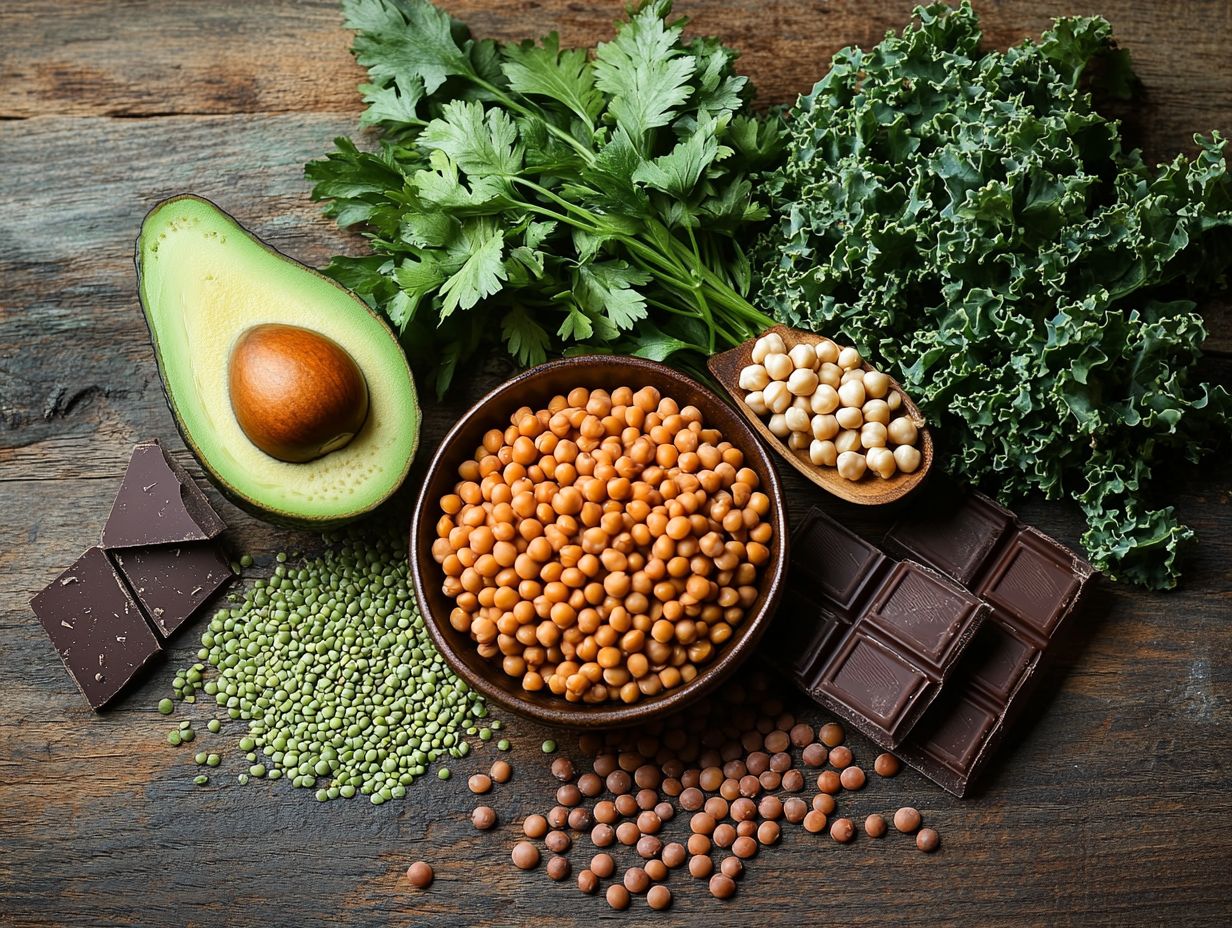 Iron absorption can be enhanced by avoiding the consumption of iron inhibitors, which include phytates found in certain grains and legumes, as well as calcium-rich foods during iron-rich meals. These inhibitors can significantly diminish the body’s ability to absorb essential iron, particularly for vegans who have limited sources of iron. To mitigate their effects, it is advisable to time meals by separating the consumption of iron-rich foods such as lentils, tofu, or spinach from foods high in phytates, like many whole grains and legumes. Additionally, incorporating vitamin C-rich foods such as citrus fruits and bell peppers alongside iron-rich foods can further enhance absorption. The timing and portioning of these food groups are important not only for optimizing iron intake but also for overall nutritional health.
Iron absorption can be enhanced by avoiding the consumption of iron inhibitors, which include phytates found in certain grains and legumes, as well as calcium-rich foods during iron-rich meals. These inhibitors can significantly diminish the body’s ability to absorb essential iron, particularly for vegans who have limited sources of iron. To mitigate their effects, it is advisable to time meals by separating the consumption of iron-rich foods such as lentils, tofu, or spinach from foods high in phytates, like many whole grains and legumes. Additionally, incorporating vitamin C-rich foods such as citrus fruits and bell peppers alongside iron-rich foods can further enhance absorption. The timing and portioning of these food groups are important not only for optimizing iron intake but also for overall nutritional health.
3. Cook Foods in Cast Iron Cookware
Cooking with cast iron cookware enhances the iron content of plant-based foods, making them more nutritious and promoting better absorption. This is particularly beneficial for vegans, as plant-based foods can often be inadequate sources of iron. When cooking with cast iron, small amounts of iron are released into the food, which can assist individuals who struggle to meet their iron requirements and those looking to prevent iron deficiency and related health issues. To maximize iron intake, meals such as hearty lentil stew cooked in a well-seasoned cast iron skillet or saut ed spinach are excellent choices, as they effectively combine flavor with nutrient density. Additionally, using cast iron for recipes that include acidic ingredients, like tomato sauces, further promotes iron absorption, making cast iron cookware an essential tool in any healthy vegan kitchen, especially for those with higher nutritional needs.
What are Some Delicious Iron-Rich Vegan Recipes?
Incorporating iron-rich recipes into a vegan diet is an excellent way to ensure adequate iron intake while adding variety to meals. Here are some iron-rich ingredients commonly used in vegan recipes:
- Legumes: Lentils, chickpeas, kidney beans, black beans, and more.
- Whole Grains: Quinoa, brown rice, oats, and whole wheat pasta.
- Nuts and Seeds: Cashews, almonds, pumpkin seeds, sesame seeds, and flaxseeds.
- Leafy Greens: Spinach, kale, Swiss chard, and beet greens.
- Dried Fruits: Apricots, raisins, and dates.
- Fortified Foods: Breakfast cereals and plant-based milk.
Vegan Iron-Rich Salad
Ingredients: This salad is full of iron-rich foods like legumes, which are essential for maintaining healthy iron levels and preventing deficiencies such as anemia. The inclusion of vitamin C-rich ingredients helps enhance non-heme iron absorption.
- 1 cup cooked quinoa
- 1 cup cooked lentils
- 1 cup chopped kale
- 1/2 cup chopped red pepper
- 1/4 cup chopped parsley
- 1/4 cup chopped red onion
- 1/4 cup pumpkin seeds
- 1/4 cup raisins
- 2 tablespoons blackstrap molasses (for extra nutrients)
- Olive oil
- Lemon juice
- Salt and pepper to taste
Instructions:
- In a large bowl, combine the quinoa, lentils, kale, red pepper, parsley, red onion, pumpkin seeds, and raisins.
- In a small bowl, whisk together the olive oil, lemon juice, salt, and pepper.
- Drizzle the dressing over the salad and toss to combine. Serve immediately or refrigerate for up to two days.
Vegan Iron-Rich Smoothie
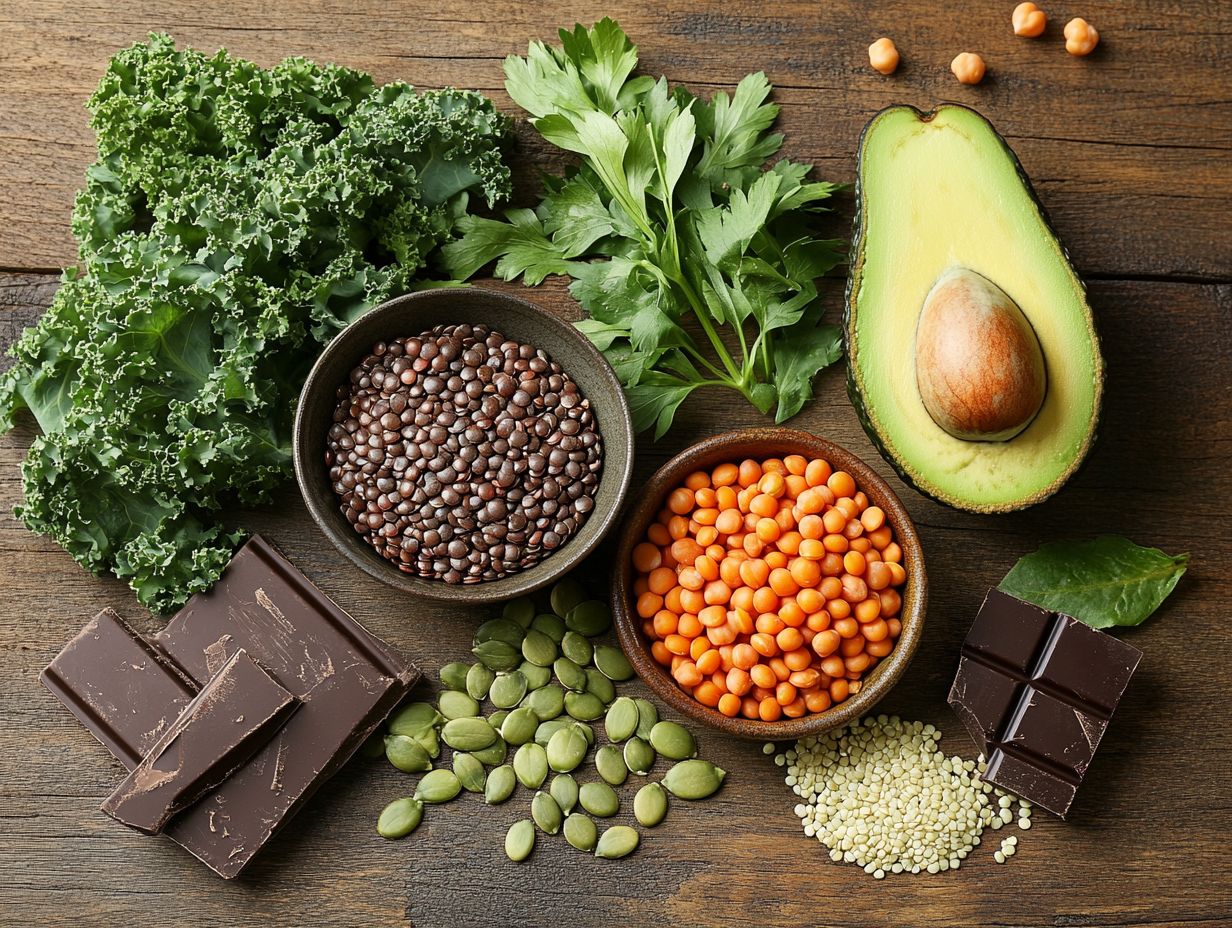 Ingredients: This smoothie is designed to meet your dietary needs, providing both calcium and potassium, essential for muscle function and energy.
Ingredients: This smoothie is designed to meet your dietary needs, providing both calcium and potassium, essential for muscle function and energy.
- 1 cup spinach
- 1/2 banana
- 1/2 cup almond milk (fortified with iron)
- 1/4 cup oats
- 1 tablespoon almond butter
- 1 tablespoon chia seeds
Instructions:
- Add all ingredients to a blender and blend until smooth.
- Pour into a glass and enjoy.
Vegan Iron-Rich Stir-Fry
Ingredients: This dish is perfect for boosting your iron intake, vital for supporting hemoglobin and myoglobin production, which are crucial for blood and muscle health.
- 1 cup cooked brown rice
- 1 cup chopped broccoli
- 1 cup chopped bok choy
- 1/2 cup sliced bell pepper
- 1/2 cup sliced carrot
- 1/2 cup sliced mushrooms
- 1/4 cup soy sauce
- 1 tablespoon sesame oil
Instructions:
- In a large skillet or wok, heat the sesame oil over medium-high heat.
- Add the bell pepper, carrot, and mushrooms, and stir-fry for 2-3 minutes.
- Add the broccoli and bok choy, and stir-fry for an additional 2-3 minutes.
- Stir in the cooked brown rice and soy sauce, and cook for another 2-3 minutes.
- Serve hot.
These recipes provide not only essential iron from plant-based sources but also a delightful variety of flavors and textures for a balanced vegan diet, promoting overall well-being and potentially reducing health issues related to iron deficiency.
1. Lentil and Vegetable Soup
Lentil and vegetable soup is a hearty, iron-rich vegan dish that offers warming comfort while being nutrient-dense. The colorful blend of vegetables in this soup introduces a variety of flavors and promotes overall health. Lentils serve as an excellent source of non-heme iron, which can help reduce fatigue and enhance immune function. Adding leafy greens or bell peppers not only enhances flavor but also provides vitamin C, which aids in iron absorption efficiency. Furthermore, spices like cumin or turmeric can be included for their anti-inflammatory properties, and quinoa can be added for extra protein and texture. This adaptable recipe can make use of seasonal vegetables, making it a versatile choice suitable for any time of year. To further boost iron intake, consider adding tofu or beans.
2. Spinach and Chickpea Curry
Spinach and chickpea curry is a delicious and iron-rich vegan dish that blends the flavors of various spices with the nutrients found in chickpeas and spinach, making it a popular choice among vegetarians. This dish offers both a variety of flavors and numerous health benefits. Spinach is packed with vitamins A, C, and K, which contribute to overall health and support the body’s iron needs. Meanwhile, chickpeas are an excellent source of protein and fiber, promoting gut health and aiding in weight management. When served over a bed of rice or alongside warm bread such as naan or pita, this flavorful curry becomes a complete meal. The combination enhances taste, adds texture, and provides a well-rounded nutritional profile for those who enjoy it. Consider adding a bit of dark chocolate for an unexpected twist and additional iron content.
3. Quinoa and Black Bean Salad
Quinoa and black bean salad is a nutrient-dense and iron-rich dish that features the complementary combination of whole grains and legumes, making it a satisfying meal option for vegans. This colorful salad not only delivers on flavor but also offers impressive health benefits, making it an excellent choice for individuals following an iron-rich diet. Both quinoa and black beans are excellent sources of iron, which is essential for a balanced diet. Vitamin C from added citrus fruits can increase the absorption of non-heme iron in this dish. The salad is versatile and can be served as a main meal, as a side dish, or as a filling for wraps. It is also easy to prepare and can be quickly whipped up, making it a great option for busy weeknight dinners or for meal prep sessions ahead of a hectic week. Additionally, this dish stores well, maintaining its freshness and flavor throughout the week. For those concerned about heart disease and cancer, the fiber content in this salad is beneficial.
4. Tofu and Broccoli Stir-Fry
Tofu and broccoli stir-fry is a quick and delicious iron-rich meal that showcases the benefits of incorporating plant-based protein and vegetables into a vegan diet. This dish combines tofu, an excellent source of iron that is crucial for hemoglobin production, with broccoli, which is rich in essential vitamins like C and K, as well as dietary fiber. The result is a meal that is both nourishing and incredibly satisfying. This stir-fry can easily be customized to suit individual tastes; for example, swapping broccoli for bell peppers or snap peas introduces new flavors while preserving nutritional value. Experimenting with different sauces, such as teriyaki, hoisin, or a spicy chili garlic blend, can enhance the flavor profile and keep mealtime exciting. This flexibility ensures that the hearty goodness of tofu and broccoli can be enjoyed in countless delightful variations. Be aware of phytates in tofu which can affect nutrients absorption, so consider adding vitamin C-rich foods to boost non-heme iron absorption.
5. Oatmeal with Almond Butter and Berries
Oatmeal with almond butter and berries is a delicious and easy breakfast option that is rich in iron and other essential nutrients, making it perfect for fueling your day. This wholesome dish not only satisfies your taste buds but also offers numerous health benefits, making it a smart choice for anyone looking to maintain a balanced diet. The oats serve as an excellent source of whole grains, contributing to heart health and providing sustained energy levels. Almond butter adds a creamy texture and is packed with healthy fats, protein, and vitamin E, while the berries are loaded with antioxidants, fiber, and vitamins that promote overall wellness. As you prepare this meal, consider experimenting with different toppings such as:
- sliced bananas
- chia seeds
- a drizzle of honey
allowing for a personalized twist on this classic breakfast that keeps your mornings exciting and nutritious. Dark chocolate shavings can be added for extra iron content and flavor.
